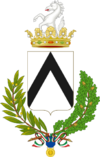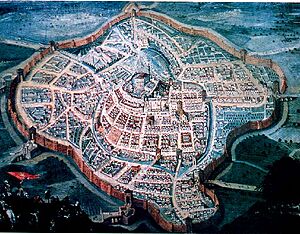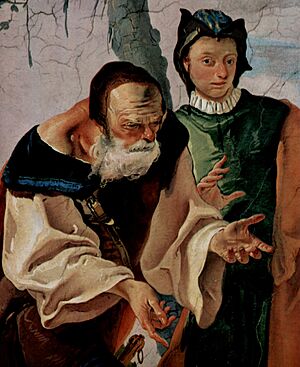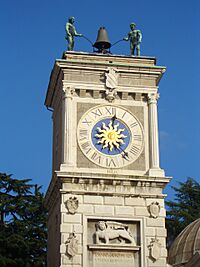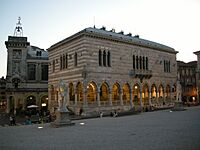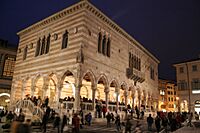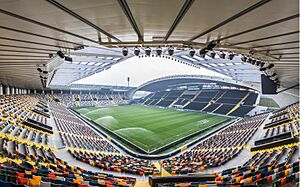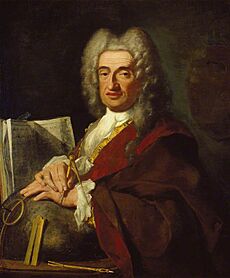Udine facts for kids
Quick facts for kids
Udine
Udin (Friulian)
|
|||
|---|---|---|---|
| Comune di Udine | |||
![Top: San Giovanni Clock Tower and Liberta Square; Angel monument at Udine Santa Maria Church; and Udine Cathedral (left to lower right); bottom: Via Mercatovecchio [it]; Loggia del Lionello; and Matteotti Square [it] (left to right)](/images/thumb/3/33/Udine_collage.png/300px-Udine_collage.png)
Top: San Giovanni Clock Tower and Liberta Square; Angel monument at Udine Santa Maria Church; and Udine Cathedral (left to lower right); bottom: Via Mercatovecchio; Loggia del Lionello; and Matteotti Square (left to right)
|
|||
|
|||
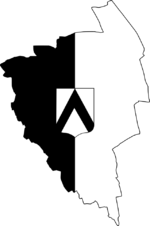
Flag map of Udine
|
|||
| Country | Italy | ||
| Region | Friuli-Venezia Giulia | ||
| Province | Udine | ||
| Frazioni | See list | ||
| Area | |||
| • Total | 56 km2 (22 sq mi) | ||
| Elevation | 113 m (371 ft) | ||
| Population
(31 December 2019)
|
|||
| • Total | 100,170 | ||
| • Density | 1,789/km2 (4,630/sq mi) | ||
| Demonym(s) | Udinese | ||
| Time zone | UTC+1 (CET) | ||
| • Summer (DST) | UTC+2 (CEST) | ||
| Postal code |
33100
|
||
| Dialing code | 0432 | ||
| Saint day | 12 July | ||
Udine (US: /ˈuːdiːneɪ/ oo-DEE-nay; Italian: [ˈuːdine]; Friulian: Udin; Latin: Utinum; Slovene: Videm) is a city in northeastern Italy. It is located in the middle of the Friuli-Venezia Giulia region. The city sits between the Adriatic Sea and the Carnic Alps. Udine is the capital of the Regional decentralization entity of Udine. In 2012, about 100,514 people lived in the city. Including the urban area, the population was around 176,000.
Contents
Discovering Udine: Names and History
What's in a Name?
The name Udine first appeared in old Latin records. It was called Udene in 983 and Utinum around the year 1000. The exact meaning of the name is not fully known. Some think it might be a very old word. It could be linked to an ancient word meaning 'hill'. This would make sense because the city has a hill.
Udine's Long History
Udine is known as the historical capital of Friuli. People have lived in this area since the Neolithic age. This was a time when early humans used stone tools.
An old Hungarian story says that Attila, the leader of the Huns, built a hill here. He needed a place to stay during winter. His soldiers carried soil in their helmets and shields. This was because the land was very flat. Attila then started the town and built a square tower.
After the Western Roman Empire fell, Udine became more important. This happened as other cities like Aquileia and Cividale declined. In 983 AD, Udine was first mentioned. Emperor Otto II gave the Utinum castle to the Patriarchs of Aquileia. They were the main rulers of the region.
In 1223, a market was started in Udine. This made the city the most important for trade in the area. It also became the main seat for the Patriarchs.
In 1420, the city was taken over by the Republic of Venice. In 1511, Udine faced a short civil war. After that, an earthquake and a plague hit the city. Udine stayed under Venetian rule until 1797. It was the second-largest city in the Venetian state.
After a short time under French rule, Udine became part of the Austrian Empire. It joined the Kingdom of Italy in 1866.
During World War I, Udine was very important. From 1915 to 1917, it was the base for the Italian High Command. People called it "Capitale della Guerra" (War Capital). After a big battle, it was occupied by German and Austro-Hungarian forces. Italy took it back in 1918. After the war, Udine became the capital of a new province. During World War II, from 1943 to 1945, the city was under German control.
Geography and Climate
Udine's Location
Udine is located in a region with a humid subtropical climate. This means it has hot, humid summers and mild winters. The city gets a lot of rain all year. Spring and autumn are the wettest seasons.
Weather Extremes
The highest temperature ever recorded in Udine was 38.2 degrees Celsius. This happened on July 21, 2006. The lowest temperature was -18.6 degrees Celsius. This was recorded on December 19, 2009.
| Climate data for Udine (Rivolto Air Base) (1991–2020, extremes 1969–present) | |||||||||||||
|---|---|---|---|---|---|---|---|---|---|---|---|---|---|
| Month | Jan | Feb | Mar | Apr | May | Jun | Jul | Aug | Sep | Oct | Nov | Dec | Year |
| Record high °C (°F) | 18.6 (65.5) |
23.2 (73.8) |
25.6 (78.1) |
29.5 (85.1) |
33.2 (91.8) |
36.2 (97.2) |
38.2 (100.8) |
37.0 (98.6) |
34.4 (93.9) |
29.8 (85.6) |
25.3 (77.5) |
17.4 (63.3) |
38.2 (100.8) |
| Mean daily maximum °C (°F) | 8.5 (47.3) |
10.2 (50.4) |
14.5 (58.1) |
18.5 (65.3) |
23.0 (73.4) |
27.2 (81.0) |
29.6 (85.3) |
29.4 (84.9) |
24.4 (75.9) |
19.1 (66.4) |
13.6 (56.5) |
9.4 (48.9) |
18.9 (66.0) |
| Daily mean °C (°F) | 4.0 (39.2) |
5.0 (41.0) |
9.0 (48.2) |
13.0 (55.4) |
17.6 (63.7) |
21.7 (71.1) |
23.7 (74.7) |
23.5 (74.3) |
18.7 (65.7) |
14.0 (57.2) |
9.1 (48.4) |
4.7 (40.5) |
13.7 (56.7) |
| Mean daily minimum °C (°F) | −0.3 (31.5) |
0.1 (32.2) |
3.6 (38.5) |
7.5 (45.5) |
12.2 (54.0) |
16.1 (61.0) |
17.9 (64.2) |
17.6 (63.7) |
13.3 (55.9) |
9.2 (48.6) |
4.8 (40.6) |
0.4 (32.7) |
8.5 (47.3) |
| Record low °C (°F) | −14.6 (5.7) |
−11.6 (11.1) |
−10.0 (14.0) |
−4.8 (23.4) |
1.4 (34.5) |
5.6 (42.1) |
8.2 (46.8) |
6.6 (43.9) |
3.0 (37.4) |
−3.2 (26.2) |
−8.4 (16.9) |
−18.6 (−1.5) |
−18.6 (−1.5) |
| Average precipitation mm (inches) | 55.19 (2.17) |
52.33 (2.06) |
69.34 (2.73) |
83.81 (3.30) |
101.77 (4.01) |
92.30 (3.63) |
75.44 (2.97) |
82.01 (3.23) |
116.63 (4.59) |
111.47 (4.39) |
125.36 (4.94) |
72.63 (2.86) |
1,038.28 (40.88) |
| Average snowfall cm (inches) | 1.0 (0.4) |
1.3 (0.5) |
0.2 (0.1) |
0.0 (0.0) |
0.0 (0.0) |
0.0 (0.0) |
0.0 (0.0) |
0.0 (0.0) |
0.0 (0.0) |
0.0 (0.0) |
0.4 (0.2) |
1.1 (0.4) |
4 (1.6) |
| Average precipitation days (≥ 1.0 mm) | 4.89 | 4.34 | 6.14 | 8.28 | 9.68 | 8.41 | 7.33 | 6.96 | 7.41 | 7.97 | 7.83 | 6.42 | 85.66 |
| Average relative humidity (%) | 74.85 | 71.72 | 70.16 | 70.11 | 71.04 | 71.13 | 69.56 | 68.96 | 71.08 | 74.74 | 77.60 | 76.16 | 72.26 |
| Average dew point °C (°F) | −1.1 (30.0) |
−0.9 (30.4) |
2.4 (36.3) |
6.3 (43.3) |
11.3 (52.3) |
14.7 (58.5) |
16.5 (61.7) |
16.1 (61.0) |
12.5 (54.5) |
9.0 (48.2) |
3.7 (38.7) |
0.1 (32.2) |
7.6 (45.6) |
| Mean monthly sunshine hours | 146.32 | 170.80 | 198.71 | 198.90 | 234.36 | 234.90 | 274.04 | 264.74 | 194.70 | 174.84 | 131.70 | 142.91 | 2,366.92 |
| Mean daily daylight hours | 9.1 | 10.4 | 11.9 | 13.6 | 15 | 15.7 | 15.3 | 14.1 | 12.5 | 10.9 | 9.5 | 8.7 | 12.2 |
| Average ultraviolet index | 2 | 3 | 5 | 6 | 8 | 9 | 9 | 8 | 6 | 4 | 3 | 2 | 5 |
| Source 1: NOAA (dew point 1981-2010) | |||||||||||||
| Source 2: Servizio Meteorologico, Nomadseason(UV), Weather atlas(Snow-Daylight) | |||||||||||||
People and Culture in Udine
Who Lives in Udine?
| Historical population | ||
|---|---|---|
| Year | Pop. | ±% |
| 1871 | 29,425 | — |
| 1881 | 31,954 | +8.6% |
| 1901 | 36,899 | +15.5% |
| 1911 | 46,916 | +27.1% |
| 1921 | 53,635 | +14.3% |
| 1931 | 63,712 | +18.8% |
| 1936 | 63,098 | −1.0% |
| 1951 | 72,908 | +15.5% |
| 1961 | 86,188 | +18.2% |
| 1971 | 100,794 | +16.9% |
| 1981 | 102,021 | +1.2% |
| 1991 | 99,189 | −2.8% |
| 2001 | 95,030 | −4.2% |
| 2011 | 98,287 | +3.4% |
| 2021 | 97,736 | −0.6% |
| Source: ISTAT | ||
In 2007, about 97,880 people lived in Udine. The wider area had twice as many people. About 14% of the population were children and teens. Around 24% were retired people. The average age in Udine is 47 years old.
Between 2002 and 2007, Udine's population grew by 1.48%. This was a bit slower than Italy's overall growth. The birth rate in Udine is about 9.13 births per 1,000 people.
Some people living near the border speak Slovene. An old document from 1475 said Slovene was spoken by the "lower class" in town. An Italian–Slovenian dictionary was even printed in Udine in 1607. However, the city does not officially recognize the Slovenian minority. Slovene is not taught in city schools.
As of 2023, most people in Udine (85.30%) are of Italian descent. Udine has many foreign residents, about 14.7% of its population. This is higher than the regional average.
Education and Arts
Udine is home to the University of Udine. The city also has important art collections. You can find them at the archbishop's palace and the Museo Civico. The city has a theater called the Teatro Giovanni da Udine.
Fun Festivals
Udine hosts several exciting festivals.
- The Friuli D.O.C. is a September festival about wine and food.
- The Premio Friuli Storia is a national award for non-fiction books.
- The Far East Film Festival in April is Europe's biggest festival for popular East Asian cinema.
An asteroid, 33100 Udine, was named after the city!
Languages Spoken
Besides Italian, the Friulian language is often spoken in Udine. A type of Venetian (called Venetin) is also spoken, but it is becoming less common.
Udine's Museums
Udine has many interesting museums to explore:
- Civici musei e gallerie di storia e arte (since 1906): This includes the Archaeological Museum, Ancient Art Gallery, and Photography Museum.
- Museo di Arte Moderna e Contemporanea: A museum for modern and contemporary art.
- Museo etnografico del Friuli (Palazzo Giacomelli): This museum focuses on the local culture and traditions.
- Gallerie del Progetto
- Museo del Duomo di Udine: The museum of Udine Cathedral.
- Museo diocesano e gallerie del Tiepolo: This museum features works by the famous artist Tiepolo.
Exploring Udine: Main Sights
Historic Buildings
The old home of the patriarchs of Aquileia is the palazzo Patriarcale. It was built in 1517 by Giovanni Fontana. It replaced an older building destroyed by an earthquake in 1511. Later, the Austrians used it as a prison.
In the 1550s, the famous architect Andrea Palladio designed some buildings in Udine. The Oratorio della Purità has beautiful frescoes from the 1700s. These were painted by Giambattista Tiepolo and his son Giandomenico.
The Church of St. Mary of the Castle is likely the oldest church in Udine. Parts of it date back to the Lombard era. It has been updated many times over the centuries. For example, its front was rebuilt after an earthquake in 1511. The church has three main sections inside. They offer a quiet and peaceful feeling. In 1487, a Venetian governor added a beautiful portico (a covered walkway) with steps leading down the hill.
Piazza della Libertà
The main square in Udine is called Piazza della Libertà. Here you will find the town hall, known as the Loggia del Lionello. It was built between 1448 and 1457. Its style is Venetian-Gothic. Across from it is a clock tower (Torre dell'Orologio). This tower looks like the one in Piazza San Marco in Venice. The Loggia del Lionello was designed by Nicolò Lionello. It was rebuilt after a fire in 1876 by architect Andrea Scala.
Next to the Loggia del Lionello is the Loggia di San Giovanni. This building was designed by Bernardino da Morcote. Other important sights in the square include:
- The Fountain by Giovanni Carrara (1542).
- Columns with the Venetian Lion and the Statue of Justice (1614).
- Statues of Hercules and Cacus.
- The Statue of Peace (1819), given by Emperor Francis I. It celebrates the peace Treaty of Campoformido.
Udine Cathedral
The Cathedral of Udine is a very large church. Its construction began in 1236. It has a Latin cross shape with three main sections and chapels on the sides. The church was officially named Santa Maria Maggiore in 1335. In the early 1700s, the Manin family paid to completely change its look. The inside is in the Baroque style and is very grand. It holds many artworks by Tiepolo, Amalteo, and Ludovico Dorigny. In the bell tower, there is a chapel. It is fully decorated with frescoes by Vitale da Bologna from 1349.
Udine Castle
The castle stands tall in the center of Udine. The Venetians built it starting in 1517. It was built on top of an older Lombard fort. That fort was damaged by an earthquake in 1511. The castle looks like a Renaissance building today. This is thanks to Giovanni da Udine, who finished the work starting in 1547. The castle has one of Europe's oldest Parliament Halls.
Other Places to See
- Orto Botanico Friulano: A lovely botanical garden.
- Parco Botanico Friulano "Cormor": A park that also has a botanical garden.
- Tempio Ossario dei Caduti d'Italia: A church built in 1931.
Economy and Transport
Udine's Economy
Udine is an important city for business and trade. It has several large shopping centers nearby. There are also important iron and mechanical industries. Companies like Danieli and ABS are major players in this field.
Getting Around Udine
The Udine railway station is the busiest in Friuli-Venezia Giulia. About 7.6 million people travel through it every year. Trains go to many Italian cities like Venice, Trieste, and Milan. You can also take international trains to Vienna and Munich.
Sports in Udine
The main football club in Udine is Udinese Calcio. It was founded in 1896. As of 2023, they have played in Italy's top league, Serie A, since the 1995–96 season. Their home stadium, the Stadio Friuli, was used for the 1990 FIFA World Cup.
The local basketball team, APU GSA, plays in the second national league, the LegaDue.
The old Stadio Moretti used to host football and motorcycle speedway races. It held important events, including qualifying rounds for the Speedway World Championship in the early 1970s.
Famous People from Udine
Many notable people were born in or are from Udine:
- Luigi De Agostini (born 1961), footballer
- Guglielmo Vicario (born 1996), footballer
- Afro Basaldella (1912–1976), painter
- Giuseppe Battiston (born 1968), actor
- Enzo Bearzot (1927–2010), national football trainer
- Mario Benedetti (1955–2020), poet
- Girolamo di Bernardino, 16th-century painter of frescoes
- Bernardino Blaceo, 16th-century painter
- Emanuele Blandamura (born 1979), boxer
- Sebastiano Bombelli (1635–1719), Baroque and Rococò painter
- José Bragato (1915–2017), cellist and composer
- Carlo Caneva (1845–1922), major general
- Eliana Cargnelutti (born 1989), blues rock musician
- Luca Carlevarijs (1663–1730), painter
- Elena Cecchini (born 1992), cyclist
- Davide Cecotti (born 1973), professional football player
- Andrea Centazzo (born 1948), drummer and composer
- Bruno Chizzo (1916–1969), footballer
- Giovanni da Udine (1487–1564), painter (Renaissance)
- Raimondo D'Aronco (1857–1932), architect
- Mario David (1934–2005), football player and coach.
- Gualtiero Driussi (1920–1996), politician
- Alfredo Foni (1911–1985), football player and coach.
- Fabio Frittelli (1966–2013), musician known as Mo-Do
- Massimo Giacomini (born 1939), former footballer and sports commentator
- Andrea Chiopris Gori (born 1977), former footballer
- Francesco Janich (1937–2019), footballer
- Dalila Di Lazzaro (born 1953), actress and model
- Ernesto Lomasti (1959–1979), mountaineer
- Guido Macor (born 1932), retired footballer
- Fabio Masotti (born 1974), cyclist
- Alberto Mazzucato (1813–1877), composer and music teacher
- Tina Modotti (1896–1942), photographer, actress, revolutionary
- Edi Orioli (born 1962), rallying motorcycle racer
- Francesco Pavona (1695–1777), Baroque painter
- Daniele Petri (born 1980), Italian darts player
- Nicola Pezzetta (born 1963), artist and architect
- Luigi Pio Tessitori (1887–1919), indologist, linguist
- Alessandro Piu (born 1996), footballer
- Bruno Pizzul (born 1938), sports journalist and footballer
- Bruno Sacco (born 1933), car designer
- Alessia Tuttino (born 1983), footballer
- Elena Valentinis (1396–1458), Roman Catholic Blessed professed religious
- Glauco Venier (born 1962), jazz pianist and composer
- Giuseppe Virgili (1935–2016), Italian footballer (striker)
- José Zanier (1905–1973), engineer
- Alessandro Zanni (born 1984), rugby union player
International Connections
Twin Towns and Sister Cities
Udine has special connections with other cities around the world. These are called twin towns or sister cities. They work together on cultural and educational projects.
Friendship Cities
Udine also has "friendship" agreements with other cities. These are less formal but still promote good relationships.
 Bikaner, India
Bikaner, India Klagenfurt, Austria
Klagenfurt, Austria Óbuda-Békásmegyer, Hungary
Óbuda-Békásmegyer, Hungary Piotrków Trybunalski, Poland
Piotrków Trybunalski, Poland Resistencia, Argentina
Resistencia, Argentina Velenje, Slovenia
Velenje, Slovenia
Images for kids
See also
 In Spanish: Údine para niños
In Spanish: Údine para niños



